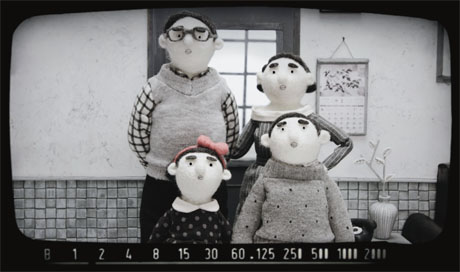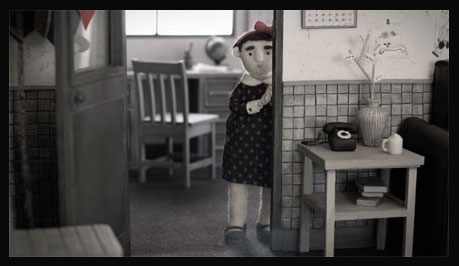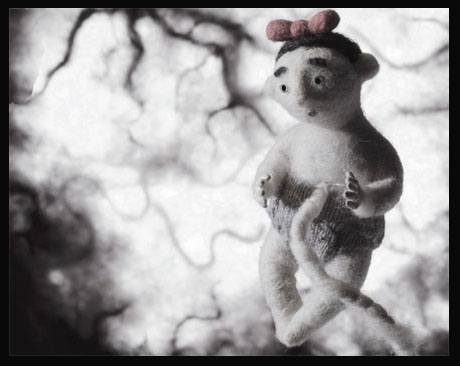
CalArts graduate and Annie Awards nominee Siqi Song’s stop-motion “Sister” is one of the 10 finalists for this year’s Best Animated Short Film Oscar. Song is humbled by the honor for her moving, powerful film.
Siqi Song: It’s definitely surreal to me. “Sister” is my first professional film. I could not imagine when I was making the film that it would have a shot at the Oscars. It’s definitely a great honor, and I appreciate everyone who has supported and helped and liked the film.

Jackson Murphy: But you’ve been with this film for a little while now because it’s been at a lot of festivals. And you were even Annie Awards nominated last awards season in the Best Student Film category for “Sister”. Is it kind of weird for you to be with one project through a couple different awards seasons?
SS: Yeah. I’m surprised it’s had a really long festival life. I sent the film to as many festivals as I could. It’s really amazing that the film can get accepted and nominated [at] so many places.
JM: And you made this at CalArts, right?
SS: Yes. It was my dream to go to CalArts and study animation. I came from China, which is really far away from animation in the Hollywood industry. CalArts is definitely a good place to learn and get my film made. I got lots of support in terms of concept and technical support. It’s definitely a great place. I don’t think I could’ve made this film without going to CalArts.
JM: The first thing that stood out to me in watching “Sister” is that most of it, but not all of it, is in black and white. What was the decision behind that?
SS: The aesthetic of the film is mostly based on the Chinese ink painting I used to do when I was a kid. In front of every story [in the short], I have a painting just like the Chinese ink painting. It’s a small representation of what’s gonna happen in that chapter. Black and white with a little bit of red is the aesthetic. It just felt to me like this film is about childhood and memories, and the imagery of those paintings represents my childhood. I kind of wanted to treat the whole film with that aesthetic. I really like to do stop-motion. I wanted to do re-create that image in stop-motion… back and forth from 2D and stop-motion. I just wanted to find the right material and color for the film.
JM: There’s a sequence early on where the baby sister is GIANT. How big are we talking in terms of proportions?
SS: Oh yeah – that baby is huge. It’s actually bigger than a real baby.
JM: Wow.
SS: Mostly everything I just made one of, so mostly everything is in scale based on the main characters. The small baby was actually smaller than my hand. The big one is bigger than a real baby.

JM: That’s amazing. There’s also a scene where the brother and sister are watching TV, and you have hand-drawn cartoons in the TV.
SS: I think those make sense because in real life we are real people, but we’re also watching 2D cartoons. When I was a kid, I watched animation all the time. That was my thing. That’s why I became an animator. Even the content of the story of “Pinocchio” [which is in this scene] was one of my favorite cartoons as a kid. Also the other film the siblings were fighting for is actually a 2D animation made by my CalArts friend. So I like having her work in my film too because I needed those two animations to go back and forth when they are fighting.
JM: When you reveal the twist about three quarters of the way through, “Sister” gets very serious. It’s about China’s One Child Policy. I saw the documentary “One Child Nation” earlier this year that explores this deeply as well. Why did you feel that this is something you wanted to tackle in animated form?
SS: I wanted to make this film because this topic, the One Child Policy, always surrounded me when I was a kid. Actually, I’m the second child in a family. I’m a little sister to a bigger brother who was four years older than me. It’s really unusual in China because back then it was really hard to have a second child. My parents tried really hard. Whenever my friends didn’t know I’m a little sister – they will always ask me, “What is it like to grow up with siblings?” I always answer this questions to friends who were the only child. They tell me that they were always supposed to have a little sister or bigger brother or bigger sister, but for One Child Policy reasons they couldn’t.
When I was talking to one of my friends from CalArts, he actually did the voiceover for the film. He told me he was supposed to have a little sister but he didn’t end-up having her because of the One Child Policy. That suddenly occurred to me that we have a really similar situation. If my parents didn’t try, I never would’ve existed – to have a life. So that’s the moment where I feel like it [became] really powerful.
JM: You use some examples of life events between the brother and sister. How was it choosing which examples and years… would work the best?

SS: That was one of the elements in the story that I had to make a lot of choices for… which stories to tell. It’s only in [a few] minutes. I can’t include everything. For each story, they all have their presentations. For the first one, the baby one, when the little sister was just born, I wanted to have this story because… I have a bigger brother, so I know what it feels like to grow up with siblings. I talk to my brother a lot about what he saw when I was just born. He told me that when you’re the only child and you suddenly have this little baby in the house, it kind of takes away the attention. I don’t remember a lot, but he told me I was really annoying. So it’s kind of a representation of what it feels like to have a newborn.
Also, the big baby and pulling out the cord is a metaphor for the abortion later. When I reveal the truth at the end, you don’t feel cheated. You can see the metaphor before you know it. The second one is about the siblings fighting each other. That’s what happened to me a lot, actually, many times – me and my brother. We fight for the TV all the time. And also, the “Pinocchio” metaphor is also telling the audience that this is all not actually true.
And the fish scene, I liked to use the fish together – as a contrast of the ending when there’s only one fish in the fishbowl. And the teeth tree was really based on my childhood memory that I thought my teeth would grow back up from the tree.
JM: Right – the tooth element was a clever idea.
SS: That’s also a metaphor of the little sister, who was asleep but she would never grow up. I chose that as the ending part because that’s the age where a child… starts to change their teeth. They start to grow up and feel the reality of everything, not to stay in the childhood phase. That’s when he realized that he already grew up. He realized the reality that his sister was never born and will never be born. I think I wanted to make every story more surreal because overall this film is a fantasy. It’s not real. So I wanted to make it more playful and child-like.
JM: You balance the surrealism with the authentic stories from your life, and it really comes through. I also want to ask you about your work on one of this year’s Best Animated Feature contenders, Laika’s “Missing Link”. You were a Junior Model Maker on it. How was your experience on that film?
SS: That was definitely a great opportunity for me to work on a bigger production. I went there after graduating from CalArts. It was definitely an eye-opening opportunity. It’s a huge step. The professionalism of the people working there – educated me a lot of the high standard of animation quality that a studio film requires. I learned a lot in terms of how to make things – in terms of every step of stop-motion animation production – and working as a team. “Sister” was a Student Film. I had like 10 people helping me work on the film. Working in a studio is really different – how to work with a team is definitely something really new to me, and I benefited from working on that.
JM: So if you get to go the Oscars, Siqi, as a nominee for Sister – and Missing Link happens to also be nominated – what would that night mean to you?
SS: I guess I’d probably see lots of puppets because every stop motion nerd likes to bring puppets as part of it. Puppets are our actors. That would be amazing. And it would also be really nice to catch up with some close friends from Laika, too.
The Best Animated Short Film Oscar nominees will be announced on January 13th. To view some of Siqi’s work on Sister and Missing Link, visit songsiqi.com
- INTERVIEW: Ready… Set… “RoboGobo” - March 24, 2025
- INTERVIEW: Building “BE@RBRICK” - March 17, 2025
- INTERVIEW: The Winning Formula For “Plankton: The Movie” - February 28, 2025


 January 3rd, 2020
January 3rd, 2020  Jackson Murphy
Jackson Murphy  Posted in
Posted in  Tags:
Tags: 






